Using Multispectral Imaging to Reveal the Relationship between UV Absorbance and Sulphur Dioxide Concentration
Abstract
1. Introduction
2. Methods
2.1. Spectral Wavelengths for Modelling
2.2. UV Camera
2.3. Control Set-Up
2.4. Calculation of Absorbance from the UV Camera Images
3. Quality Assurance of the Control Set-Up
3.1. Device Stability Test
3.2. Blank Control Test
3.3. Repeatability Test
4. Experiment and Analysis
4.1. Analysis of UV Absorbance by Different SO2 Concentrations at Multiple UV Wavelengths
4.2. The Influence of Gas Flow Rate
4.3. The Influence of Relative Humidity
4.4. The Influence of Temperature
4.5. Integrated Look-Up Tables (LUTs) for an Array of Environmental Factors
4.6. Noise Removal for LUTs
5. Conclusions
Author Contributions
Funding
Institutional Review Board Statement
Informed Consent Statement
Data Availability Statement
Conflicts of Interest
References
- Sunyer, J.; Ballester, F.; Tertre, A.L.; Atkinson, R.; Ayres, J.G.; Forastiere, F.; Forsberg, B.; Vonk, J.M.; Bisanti, L.; Tenías, J.M. The association of daily sulfur dioxide air pollution levels with hospital admissions for cardiovascular diseases in Europe (The Aphea-II study). Eur. Heart J. 2003, 24, 752–760. [Google Scholar] [CrossRef] [PubMed]
- Weibring, P.; Edner, H.; Svanberg, S.; Cecchi, G.; Pantani, L.; Ferrara, R.; Caltabiano, T. Monitoring of volcanic sulphur dioxide emissions using differential absorption lidar (DIAL), differential optical absorption spectroscopy (DOAS), and correlation spectroscopy (COSPEC). Appl. Phys. B Lasers Opt. 1998, 67, 419. [Google Scholar] [CrossRef]
- Okabe, H.; Splitstone, P.L.; Ball, J.J. Ambient and source SO2 detector based on a fluorescence method. J. Air Pollut. Control Assoc. 1973, 23, 514–516. [Google Scholar] [CrossRef]
- Schiavon, G.; Zotti, G.; Toniolo, R.; Bontempelli, G. Amperometric monitoring of sulphur dioxide in liquid and air samples of low conductivity by electrodes supported on ion-exchange membranes. Analyst 1991, 116, 797–801. [Google Scholar] [CrossRef]
- Clarisse, L.; Hurtmans, D.; Clerbaux, C.; Hadji-Lazaro, J.; Ngadi, Y.; Coheur, P.-F. Retrieval of sulphur dioxide from the infrared atmospheric sounding interferometer (IASI). Atmos. Meas. Tech. 2012, 5, 581–594. [Google Scholar] [CrossRef]
- Bluth, G.; Shannon, J.; Watson, I.; Prata, A.; Realmuto, V. Development of an ultra-violet digital camera for volcanic SO2 imaging. J. Volcanol. Geotherm. Res. 2007, 161, 47–56. [Google Scholar] [CrossRef]
- Moffat, A.J.; Millan, M.M. The applications of optical correlation techniques to the remote sensing of SO2 plumes using sky light. Atmos. Environ. 1971, 5, 677–690. [Google Scholar] [CrossRef] [PubMed]
- Galle, B.; Oppenheimer, C.; Geyer, A.; McGonigle, A.J.; Edmonds, M.; Horrocks, L. A miniaturised ultraviolet spectrometer for remote sensing of SO2 fluxes: A new tool for volcano surveillance. J. Volcanol. Geotherm. Res. 2003, 119, 241–254. [Google Scholar] [CrossRef]
- Kern, C.; Werner, C.; Elias, T.; Sutton, A.J.; Lübcke, P. Applying UV cameras for SO2 detection to distant or optically thick volcanic plumes. J. Volcanol. Geotherm. Res. 2013, 262, 80–89. [Google Scholar] [CrossRef]
- Nadeau, P.A. Ultraviolet Digital Imaging of Volcanic Plumes: Implementation and Application to Magmatic Processes at Basaltic Volcanoes. Ph.D. Thesis, Michigan Technological University, Houghton, MI, USA, 2011. [Google Scholar]
- Nisulescu, C.; Ionel, I.; Calinoiu, D. New methods for determination SO2 emissions. In Proceedings of International Conference Integrated Systems for Agro Food Production, SIPA, Sibiu, Romania, 26–29 September 2013; pp. 10–12. [Google Scholar]
- Berg, N.; Mellqvist, J.; Jalkanen, J.; Balzani, J. Ship emissions of SO2 and NO2: DOAS measurements from airborne platforms. Atmos. Meas. Tech. 2012, 5, 1085–1098. [Google Scholar] [CrossRef]
- Prata, A. Measuring SO2 ship emissions with an ultraviolet imaging camera. Atmos. Meas. Tech. 2014, 7, 1213–1229. [Google Scholar] [CrossRef]
- Khan, S.; Newport, D.; Le Calvé, S. Gas Detection Using Portable Deep-UV Absorption Spectrophotometry: A Review. Sensors 2019, 19, 5210. [Google Scholar] [CrossRef] [PubMed]
- Caballero, D.; Calvini, R.; Amigo, J.M. Hyperspectral imaging in crop fields: Precision agriculture. In Data Handling in Science and Technology; Elsevier: Amsterdam, The Netherlands, 2020; Volume 32, pp. 453–473. [Google Scholar]
- Li, X.-X.; Wang, Y.; Xu, P.-P.; Zhang, Q.-Z.; Nie, K.; Hu, X.; Kong, B.; Li, L.; Chen, J. Effects of temperature and wavelength choice on in-situ dissolution test of Cimetidine tablets. J. Pharm. Anal. 2013, 3, 71–74. [Google Scholar] [CrossRef] [PubMed]
- Wittrock, F.; Oetjen, H.; Richter, A.; Fietkau, S.; Medeke, T.; Rozanov, A.; Burrows, J. MAX-DOAS measurements of atmospheric trace gases in Ny-Ålesund-Radiative transfer studies and their application. Atmos. Chem. Phys. 2004, 4, 955–966. [Google Scholar] [CrossRef]
- Platt, U.; Stutz, J. Differential absorption spectroscopy. In Differential Optical Absorption Spectroscopy; Springer: Berlin/Heidelberg, Germany, 2008; pp. 135–174. [Google Scholar]
- Taylor, J.K. Quality Assurance of Chemical Measurements; CRC Press: Boca Raton, FL, USA, 1987. [Google Scholar]
- Madden, H.H. Comments on the Savitzky-Golay convolution method for least-squares-fit smoothing and differentiation of digital data. Anal. Chem. 1978, 50, 1383–1386. [Google Scholar] [CrossRef]
- Guiñón, J.L.; Ortega, E.; García-Antón, J.; Pérez-Herranz, V. Moving average and Savitzki-Golay smoothing filters using Mathcad. Pap. ICEE 2007, 2007, 1–4. [Google Scholar]
- Jenks, G.F. The Data Model Concept in Statistical Mapping. Int. Yearb. Cartogr. 1967, 7, 186–190. [Google Scholar]
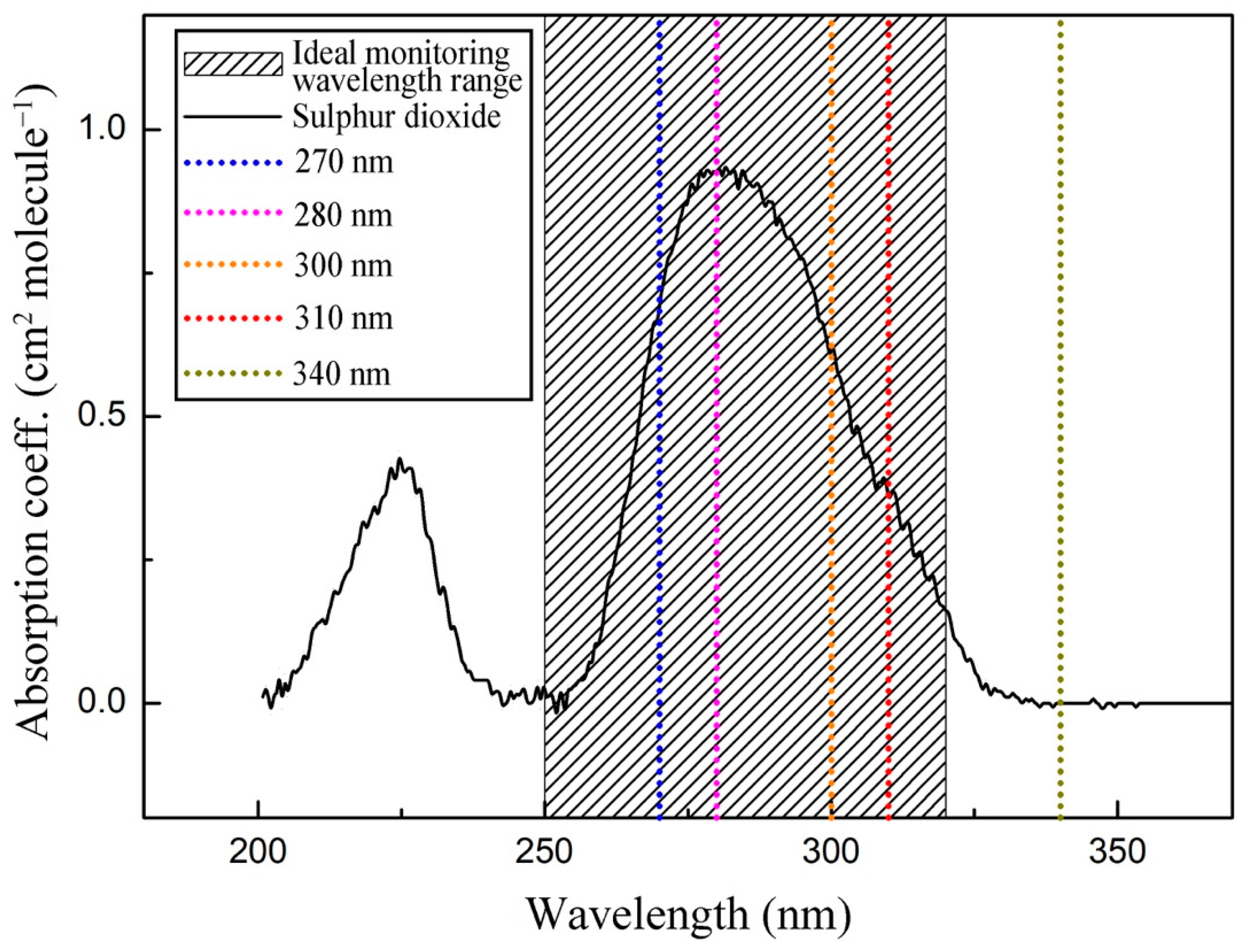



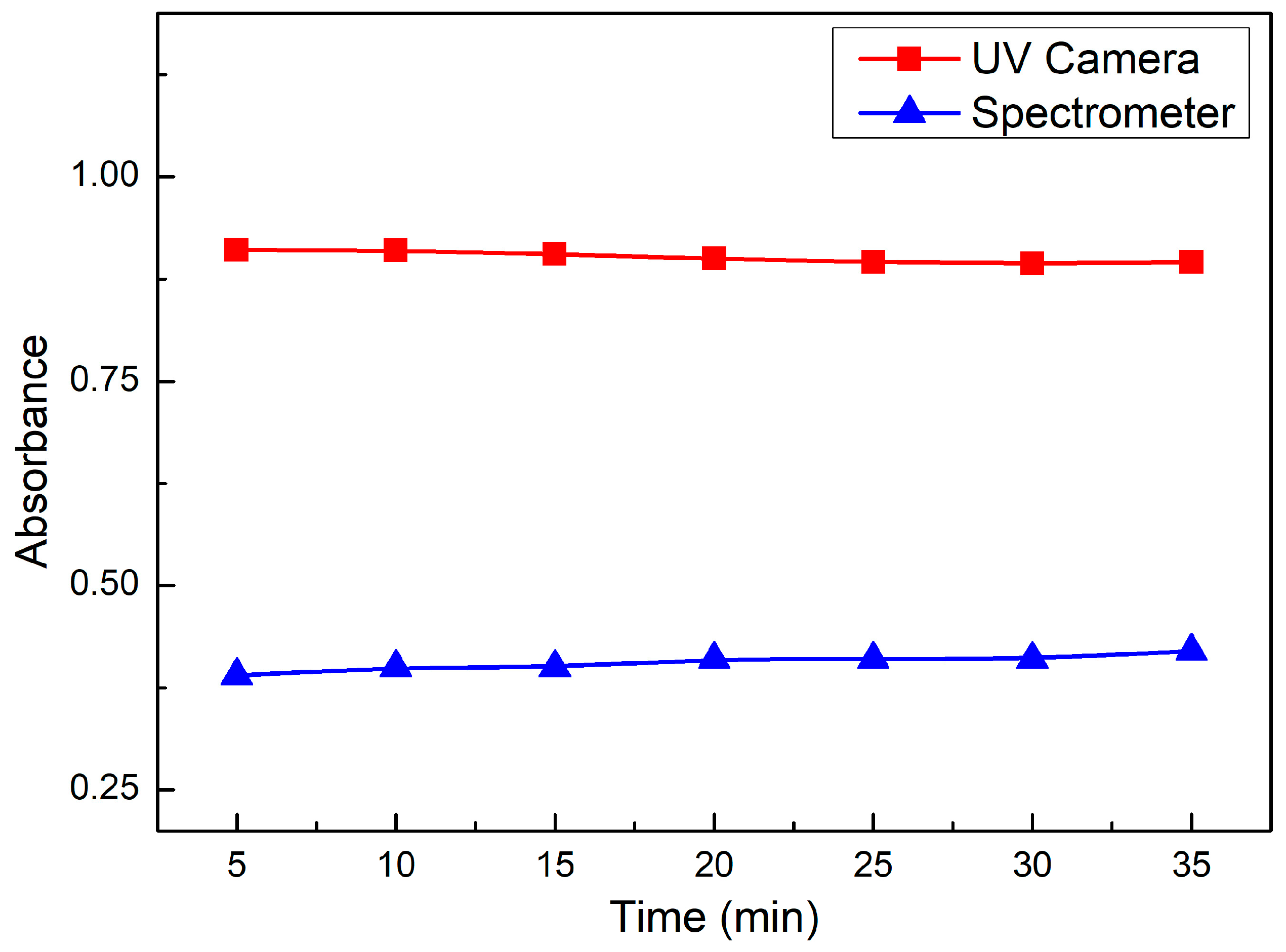

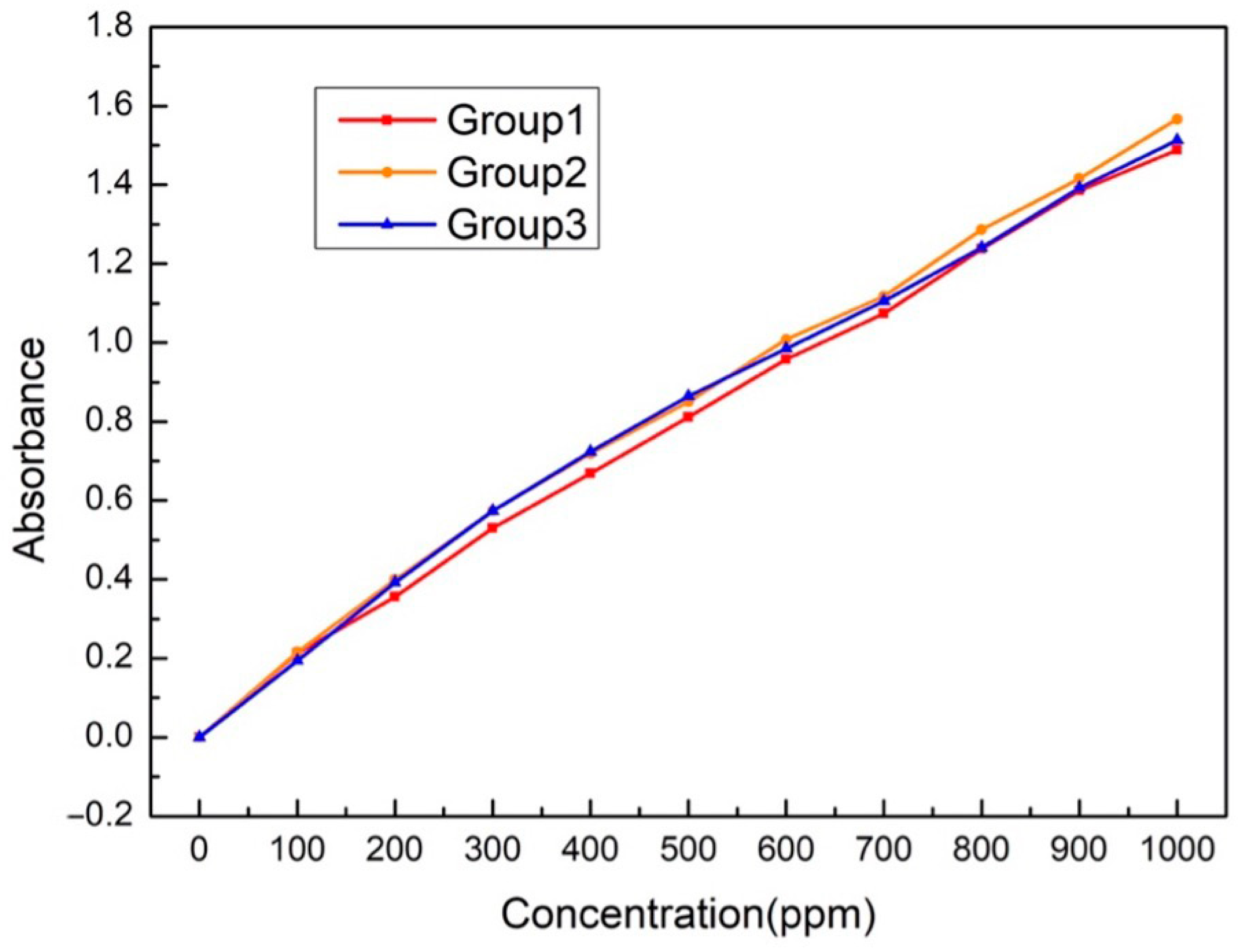


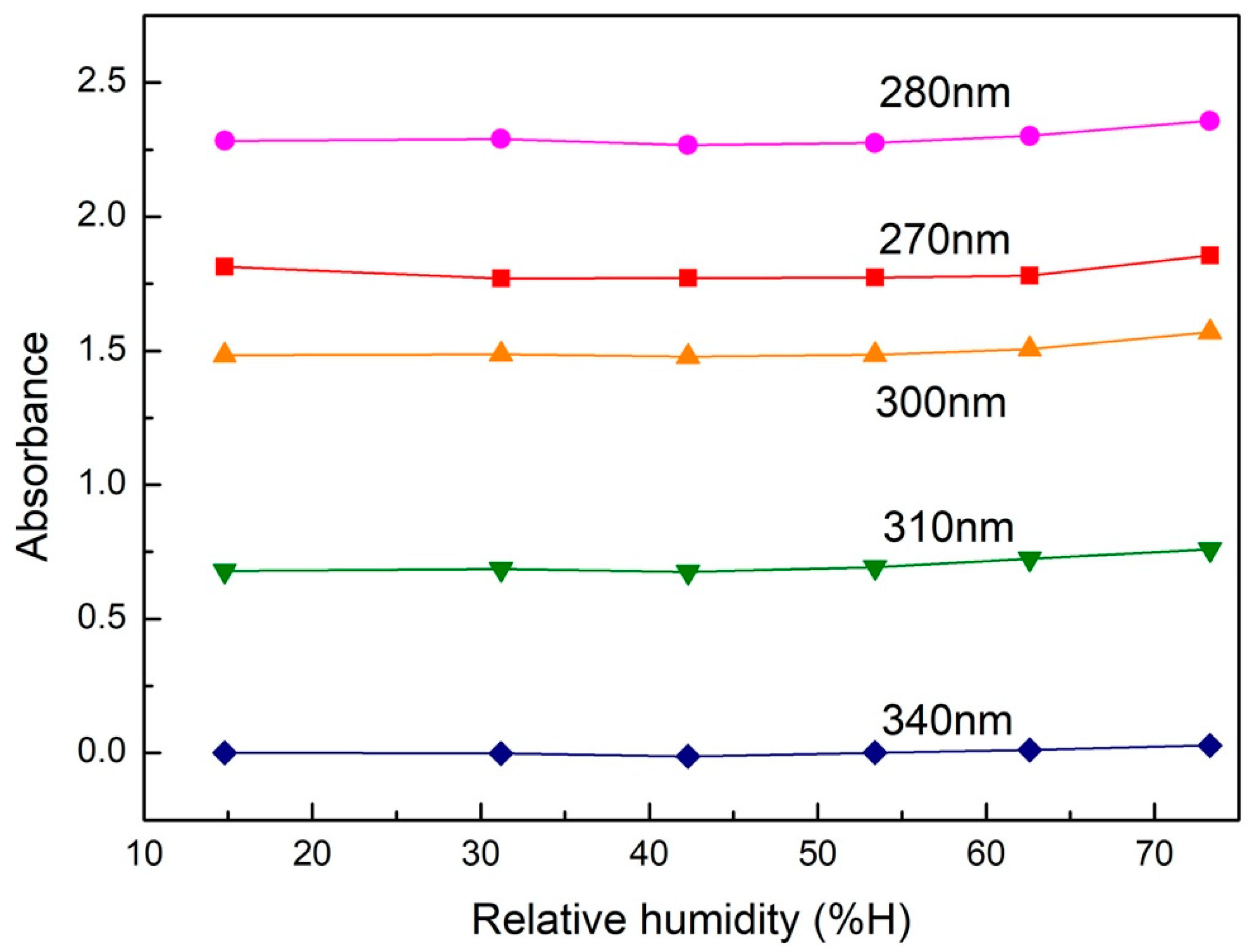


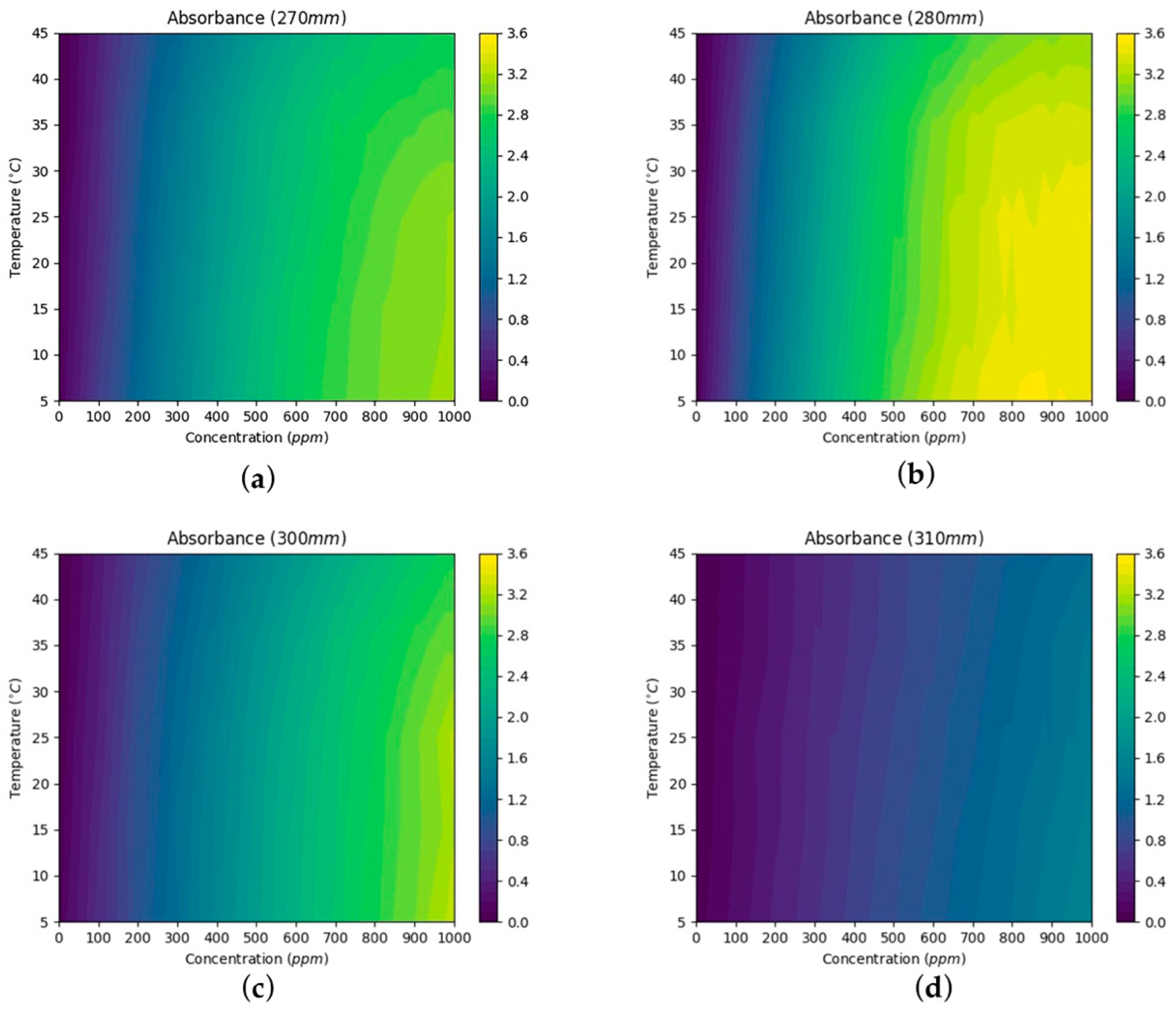


| Items | Values |
|---|---|
| Narrow-band-pass filters (nm) | 270, 280, 300, 310, 340 |
| SO2 concentrations (ppm) | Interval = 20 ppm, range = from 0 to 1000 |
| Exposure time (s) | 0.2, 1.0, 1.8 |
| Temperature (°C) | 25 |
| Items | f16 |
| CWL | a | b | c | R2 |
|---|---|---|---|---|
| 270 nm | −2.6853 × 10−6 | 5.7887 × 10−3 | −2.2263 × 10−4 | 0.9995 |
| 280 nm | −4.1456 × 10−6 | 7.5761 × 10−3 | 1.0812 × 10−3 | 0.9992 |
| 300 nm | −1.1977 × 10−6 | 4.3508 × 10−3 | 2.5618 × 10−2 | 0.9995 |
| 310 nm | −2.9712 × 10−7 | 1.7151 × 10−3 | 3.1292 × 10−2 | 0.9987 |
| Temperature | CWL | a | b | c | R2 |
|---|---|---|---|---|---|
| 5 °C | 270 nm | −3.1501 × 10−6 | 6.1824 × 10−3 | 7.6253 × 10−2 | 0.9995 |
| 280 nm | −4.6217 × 10−6 | 7.9696 × 10−3 | 9.9150 × 10−2 | 0.9995 | |
| 300 nm | −1.2499 × 10−6 | 4.3789 × 10−3 | 9.1311 × 10−2 | 0.9994 | |
| 310 nm | −3.2138 × 10−7 | 1.8563 × 10−3 | 4.8064 × 10−2 | 0.9994 | |
| 15 °C | 270 nm | −3.1394 × 10−6 | 6.2253 × 10−3 | 6.4294 × 10−3 | 0.9996 |
| 280 nm | −4.3782 × 10−6 | 7.7215 × 10−3 | 3.8784 × 10−2 | 0.9994 | |
| 300 nm | −1.4124 × 10−6 | 4.5101 × 10−3 | 5.0661 × 10−2 | 0.9997 | |
| 310 nm | −3.2119 × 10−7 | 1.8342 × 10−3 | 1.9879 × 10−2 | 0.9998 | |
| 25 °C | 270 nm | −2.6853 × 10−6 | 5.7887 × 10−3 | −2.2263 × 10−4 | 0.9995 |
| 280 nm | −4.1456 × 10−6 | 7.5761 × 10−3 | 1.0812 × 10−3 | 0.9992 | |
| 300 nm | −1.1977 × 10−6 | 4.3508 × 10−3 | 2.5618 × 10−2 | 0.9995 | |
| 310 nm | −2.9712 × 10−7 | 1.7151 × 10−3 | 3.1292 × 10−2 | 0.9987 | |
| 35 °C | 270 nm | −2.8896 × 10−6 | 5.9008 × 10−3 | −7.0890 × 10−2 | 0.9995 |
| 280 nm | −4.2674 × 10−6 | 7.6865 × 10−3 | −9.3008 × 10−2 | 0.9992 | |
| 300 nm | −1.2219 × 10−6 | 4.2704 × 10−3 | −2.1961 × 10−2 | 0.9995 | |
| 310 nm | −1.7656 × 10−7 | 1.5844 × 10−3 | 1.2982 × 10−2 | 0.9993 | |
| 45 °C | 270 nm | −2.3689 × 10−6 | 5.1818 × 10−3 | −7.6330 × 10−2 | 0.9992 |
| 280 nm | −3.4423 × 10−6 | 6.6780 × 10−3 | −1.2121 × 10−1 | 0.9987 | |
| 300 nm | −1.0131 × 10−6 | 3.8102 × 10−3 | −2.8500 × 10−2 | 0.9998 | |
| 310 nm | −3.8191 × 10−7 | 1.6842 × 10−3 | −5.4825 × 10−3 | 0.9996 | |
| 5 °C | 270 nm | −3.1501 × 10−6 | 6.1824 × 10−3 | 7.6253 × 10−2 | 0.9995 |
| 280 nm | −4.6217 × 10−6 | 7.9696 × 10−3 | 9.9150 × 10−2 | 0.9995 | |
| 300 nm | −1.2499 × 10−6 | 4.3789 × 10−3 | 9.1311 × 10−2 | 0.9994 | |
| 310 nm | −3.2138 × 10−7 | 1.8563 × 10−3 | 4.8064 × 10−2 | 0.9994 |
| Temperature (°C) | 5 | 15 | 25 | 35 | 45 |
|---|---|---|---|---|---|
| Max SD | 0.065 | 0.052 | 0.056 | 0.066 | 0.086 |
Disclaimer/Publisher’s Note: The statements, opinions and data contained in all publications are solely those of the individual author(s) and contributor(s) and not of MDPI and/or the editor(s). MDPI and/or the editor(s) disclaim responsibility for any injury to people or property resulting from any ideas, methods, instructions or products referred to in the content. |
© 2022 by the authors. Licensee MDPI, Basel, Switzerland. This article is an open access article distributed under the terms and conditions of the Creative Commons Attribution (CC BY) license (https://creativecommons.org/licenses/by/4.0/).
Share and Cite
Lu, K.; Li, Z.; Wong, M.S. Using Multispectral Imaging to Reveal the Relationship between UV Absorbance and Sulphur Dioxide Concentration. Sustainability 2023, 15, 138. https://doi.org/10.3390/su15010138
Lu K, Li Z, Wong MS. Using Multispectral Imaging to Reveal the Relationship between UV Absorbance and Sulphur Dioxide Concentration. Sustainability. 2023; 15(1):138. https://doi.org/10.3390/su15010138
Chicago/Turabian StyleLu, Keru, Zhilin Li, and Man Sing Wong. 2023. "Using Multispectral Imaging to Reveal the Relationship between UV Absorbance and Sulphur Dioxide Concentration" Sustainability 15, no. 1: 138. https://doi.org/10.3390/su15010138
APA StyleLu, K., Li, Z., & Wong, M. S. (2023). Using Multispectral Imaging to Reveal the Relationship between UV Absorbance and Sulphur Dioxide Concentration. Sustainability, 15(1), 138. https://doi.org/10.3390/su15010138







